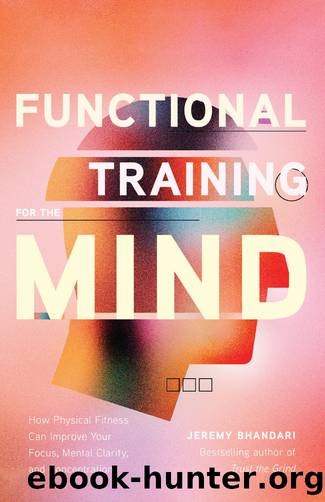Functional Training for the Mind by Jeremy Bhandari

Author:Jeremy Bhandari
Language: eng
Format: epub
Publisher: Mango Media
Published: 2023-04-14T00:00:00+00:00
Chapter 6
BREATHE
All living beings are breathing, but some living beings breathe more efficiently than others. Since itâs an involuntary action, most individuals donât take the time, or energy, to polish their inhaling and exhaling technique. Despite how primitive the actual act may appear, each time you gasp for air, there is more going on internally than you could ever imagine, and your performance in the effort can strongly influence your stress levels, blood pressure, feelings of well-being, and overall ability to forcefully function.
The dynamics of a complete breath affect the entire body. On average, humans breathe in and out about 22,000 times per day. Breathing is what keeps the symbolic battery in our beings activated. The explanation of the process is rather elementary: Our lungs service us with oxygen. When we breathe in air, the lungs allow the oxygen to pass into our bloodstream. From there, it is lugged off to the tissues and organs, which allows us to function as lively beings. When we breathe out, our lungs take carbon dioxide from our blood and discharge it into the atmosphere. The better we can breathe, the more we can achieve.
Typically, our lungs become fully developed between twenty and twenty-five years old. Once you hit your mid-thirties, it is common for your lungs to slowly decline in overall performance as the years go by. This is why itâs ever-so-important to consistently monitor their capabilities, so that as you age, your breathing remains at the top of its game, and you can continue to operate as a flourishing being.
In order to regularly examine the performance of the pair of organs in your chest that equip your body with oxygen, it would be beneficial to have some background knowledge. Your brain determines the speed at which your lungs are able to gather air. For example, if youâre on a run and moving at a brisk pace, your brain will signal to the lungs that they must operate at a quicker rate in order to effectively draw in the invisible gaseous substance surrounding the Earth. On the flip side, when your body is dormant, your lungs are instructed to slow down.
Humans are equipped with two lungs. The left lung has a pair of lobes, while the right lung has a set of three. As far as size goes, the lung on the left side of the body is actually a tad smaller than its counterpart, as space in that area is specifically fitted for the heart. The amount of air that a set of lungs can hold differs from being to being.
Physiological factors that can impact the volume of our lungs include age, gender, weight, height, ethnicity, attitude, and physical activity, among others. Taller people have larger lungs, and males, for the most part, have bigger lungs than females. Individuals who habitually exercise have a large lung capacity, which allows them to move oxygen around their body faster than those who donât typically test their cardiovascular system by way of a physical workout.
Download
This site does not store any files on its server. We only index and link to content provided by other sites. Please contact the content providers to delete copyright contents if any and email us, we'll remove relevant links or contents immediately.
Men In Love by Nancy Friday(5203)
Everything Happens for a Reason by Kate Bowler(4704)
The Immortal Life of Henrietta Lacks by Rebecca Skloot(4552)
Why We Sleep by Matthew Walker(4397)
The Sports Rules Book by Human Kinetics(4348)
Not a Diet Book by James Smith(3382)
The Emperor of All Maladies: A Biography of Cancer by Siddhartha Mukherjee(3115)
Sapiens and Homo Deus by Yuval Noah Harari(3036)
Day by Elie Wiesel(2753)
Angels in America by Tony Kushner(2624)
A Burst of Light by Audre Lorde(2573)
Endless Forms Most Beautiful by Sean B. Carroll(2448)
Hashimoto's Protocol by Izabella Wentz PharmD(2353)
Dirty Genes by Ben Lynch(2296)
Reservoir 13 by Jon McGregor(2267)
Wonder by R J Palacio(2184)
And the Band Played On by Randy Shilts(2170)
The Immune System Recovery Plan by Susan Blum(2042)
Stretching to Stay Young by Jessica Matthews(2014)
